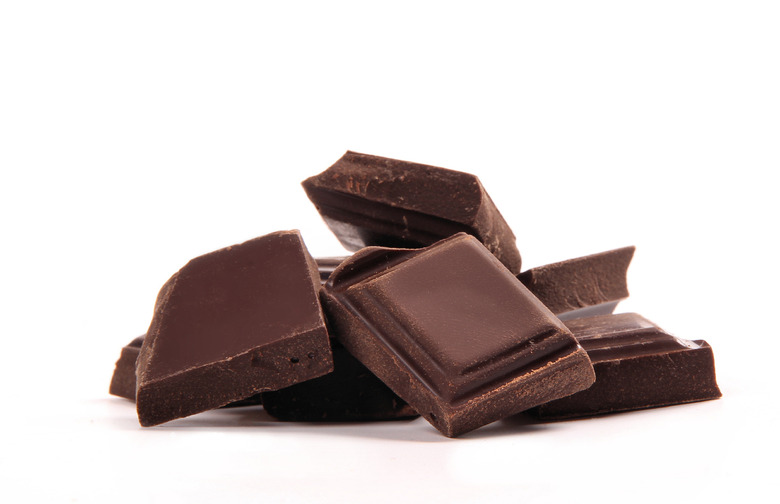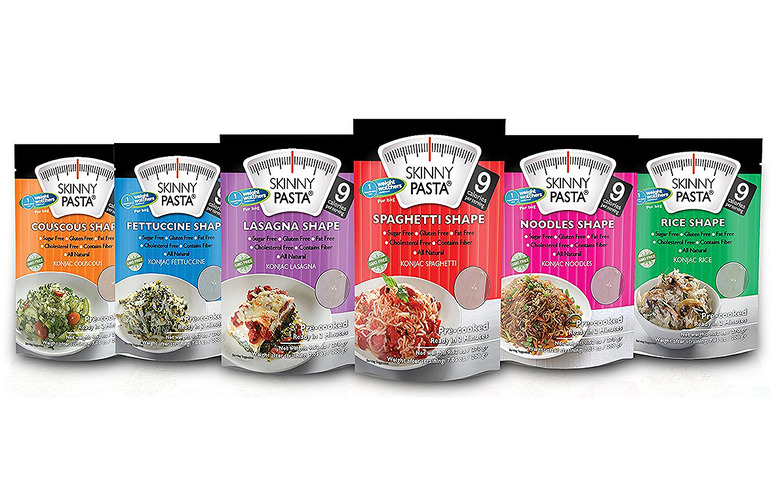The 15 Grossest Diet Foods In History Slideshow
Dieting is a practice dating back hundreds of years, with evidence of weight loss attempts stretching as far back as the early nineteenth century. At some points in history, weight gain has actually been applauded — with advertisements for fattening products warning women, "Don't let them call you skinny" being published from the '30s to the '50s in America. But for much of the past century, weight loss has been the key to an appealing social stature.
The methods by which people attempted to lose weight have been varied and ridiculous. The cabbage soup diet, weight loss teas, and meal replacements were par for the course over the years. But every now and then, a diet food manufacturer has gone just a little too far with their claims — and their product. Some of these diet products are 99 percent chemical. Some are chewier than an old piece of bubblegum (and less satisfying). And some are even toxic to the digestive system, causing widespread diarrhea and vomiting after their release.
Unfortunately, a few of the products on this list are still on the market today — though some have been buried in deep, dark diet history. Of all the products that have been sold in diet-obsessed times, these were the absolute grossest.
Ayds Diet Candy
In the 1970s and 1980s, Ayds — an appetite suppressing candy — was a top-selling diet food. It came in chocolate, caramel, and butterscotch flavors. The gross part? One of the main ingredients was phenylpropanolamine, a stimulant used on dogs to control bladder problems. It's outlawed in Canada and can cause excessive sweating, drying up of mucus glands, and even strokes.
The unfortunately-named product was forced off the shelves in the mid-1980s when the AIDS crisis gained media attention. "Why take diet pills when you can enjoy Ayds?" their ads recited.
Choco-Rite Curb Bites
In case you thought appetite control candy was a thing of the past, it didn't end with Ayds — Choco-Rite is a modern-day product claiming to curb your chocolate cravings with Hoodia gordonii, a fleshy, cactus-like plant.
The first and second ingredients are insoluble plant fibers, while chocolate liquor arrives third. From there it only gets worse, with ingredients like palm kernel oil, milk fat, and over five unpronounceable fillers and chemicals. They must be chewy, that's for sure.
Cotton Balls
This trend started with models. They began eating cotton balls under the premise that the high fiber content of the pillow-like cosmetic tools would keep their stomachs full for longer. They would dip the cotton balls in orange juice to get them down without choking, gobbling up five at a time. The bleach-soaked, polyester fibers are not only tasteless and stringy, but as you can imagine, they're also pretty bad for your health. Eating too many caused many dieters to experience obstructions of their intestinal tract called bezoars. They could completely block the waste system altogether.
KE Diet Powder
This substance was an unfortunate concoction devised by the creators of the KE Diet — a regimen wherein dieters are fed a gelatinous paste through a feeding tube. That paste was made exclusively from KE Powder, an infusion of proteins, fats, and micronutrients with no carbohydrates, mixed with water.
Practitioners of the diet would carry the pump with them at all times and required supervision from a doctor. The Academy of Nutrition and Dietetics warned that the paste tube injections could cause infection and illness, in addition to really, really bad breath.
Konjac Pasta
This gum-like pasta replacement is heavily endorsed by Weight Watchers under the brand Skinny Pasta and is currently being popularized all over the United States. The jelly-like noodles consist of a subtropical plant fiber also known as devil's tongue, voodoo lily, and elephant yam. They're incredibly chewy and have the potential to cause a laxative effect.
40 percent of the substance is made from dietary fiber, which makes the plant into a viscous paste that can be morphed into noodles. Two pounds of the stuff amounts to just 60 calories, and has enough fiber to take out a 200 pound man.
Leaner Creamer
It's a cream that doesn't contain any dairy or other form of milk — instead, its main ingredient is oil. Its other eleven ingredients are names of various chemicals, ranging from silicon dioxide to sodium caseinate (a milk derivative).
"I might as well throw dirt in my coffee it's so gross," said one reviewer on Amazon. Other tasters of the product felt similarly — objecting to a grainy texture and a tasteless muck. "It's hard and clumpy doesn't dissolve," said another.
McDonald’s McLean Deluxe Burgers
In the late 1980s and early '90s, McDonald's started to receive some serious criticism for serving up an artery-clogging menu. Since then, the criticism hasn't ceased — but they've luckily gotten a whole lot better at offering other options. But in 1991, the fast food chain debuted the "McLean Deluxe Burger"—a "diet-friendly" patty boasting less than half the fat content of McDonald's regular burger.
To accomplish this miracle feat, they stuffed their burger meat with water and seaweed. Since they'd removed all the fat, the meat fell apart and would no longer bind together. To remedy the issue, they suffused the patties with carrageenan, a seaweed substance that was virtually tasteless. Needless to say, the item didn't make it. Womp, womp.
Simple Girl Zero-Calorie Salad Dressing
Simple Girl took all the fats and oils out of dressing and just left behind the calorie-less flavorings — a good idea in theory, but in practice a recipe for a vinegar-y, acidic, watery mess to pour over your salad. If there's anything your fiber-filled vegetables didn't need, it was fewer calories.
Simple Girl's main ingredient is water, followed by vinegar, some spices and fillers, and a whole lot of stevia — a plant-based sweetener that's 40 times sweeter than normal sugar. The result tastes gruesome (in this editor's opinion) and removes all the benefits of healthful oil dressings from a salad.
South Western Omelet Mix
Once mixed with water, this powdered blend makes a diet-friendly egg white omelette (though the recent consensus is that egg yolks are plenty good for you). We didn't ask how they made eggs into a powder — frankly, we didn't want to know — but between the dehydrated vegetables and addition of scoops of whey, we don't think we'd enjoy it.
Somehow, the vegetable-filled product has less than a gram of fiber. What's in the vegetables, then? We're confused.
Tapeworms
In the early 1900s, people were already desperately attempting weight loss. They would eat live tapeworms with the hopes of it lodging in their stomach and making a home — then, the tapeworm would absorb all their calories for them. Swallowing a live worm? Not worth it, if you ask us. But unfortunately, the societal obsession with thinness remains strong, and some people are reportedly still choking down these parasites. Can you say ew?
Thin Slim Foods Bagels
These low-carb bagels make some drastic claims — evidently, they have no effect on your blood sugar, they have 14 grams of protein, and they taste similarly to normal bagels. Well, that last claim is a bit of a stretch.
"These are the worst things I have ever put in my mouth," said one revolted Amazon reviewer. "That was 4 days ago and my stomach still turns to think about this horrible, horrible fake bagel." Keto dieters had flocked to the product for its appealing lack of carbohydrates, only to throw the entire bag in the trash when they discovered the rock-solid, off-putting reality.
"I'm dead serious when I say I gagged trying to choke it down," said another disappointed review.
We're honestly not surprised. The first ingredient in this "bread" product is whey protein. Sweetened with stevia, and fluffed up with various starchy compounds, it's no wonder the 100-calorie bagels taste so awful. We'll stick to our carbs, thank you very much.
Vinegar-Soaked Potatoes
Lord Byron, poet, politician, and notorious romantic, was very conscious of his weight. He was the diet icon of his century, often lamenting his "morbid propensity to fatten." On one of his crash diets, he subsisted solely on potatoes that had been soaked to the core in harsh vinegar. The drenched spuds made for grotesque breakfasts, lunches, and dinners — but inevitably, he always binged on elaborate meals after dark. Perhaps the first crash dieter ever recorded, Byron died at age 36 of a fever at a weight that was (by his standards) too heavy.
Walden Farms Zero Calorie Marshmallow Dip
Marshmallow fluff is a decadent, whipped dessert worthy of s'mores cakes and ice cream sundaes. This product, on the other hand, is worthy of the trash.
We don't think you should ever put this gooey white stuff near your mouth — it's made of water, cellulose gel, more gums, and sucralose. That's the sweetener they add in diet soda. Not a single ingredient in this sticky mess of artificiality has any nutritional value whatsoever, and though we haven't tried it for ourselves, there's no way it could taste good. It's 99 percent water and fiber-y gel.
WINK Frozen Desserts
This brand is a prime example of low-calorie ice cream gone wrong. With such successful derivatives on the market like Halo Top and Low Cow, we're shocked WINK is still in business — their pints are 100 calories each, consisting solely of pea protein, sweeteners, and gum fillers. We tried WINK and concluded that the protein slush was an abominable excuse for ice cream. It tastes like what it's made of — frozen, watery vegan protein.
WOW! Chips
In 1998, Frito-Lay thought they'd found the ultimate solution to dieter's woes — olestra. The substance imitated the feel and taste of greasy fat molecules without providing any of the actual fat. They immediately capitalized on the opportunity, releasing WOW! Chips, entirely fat-free.
Millions of Americans bought the packages, thrilled with their newly uninhibited snacking possibilities. Until they ate the chips — and sprinted to the toilet. It turns out that olestra is a forceful laxative; it caused intense diarrhea and stomach pains in those who indulged. The effect was so severe that the Food and Drug Administration required a warning label on the front of the package. This is definitely a food doctors won't eat.















